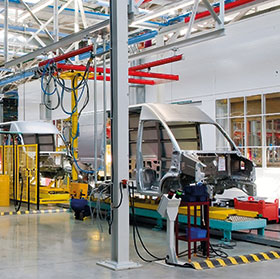

IO-Link (IEC61131-9) is an open standard serial communication protocol that allows for the bidirectional exchange of data from sensors and devices that support IO-Link and are connected to a master. The IO-Link master can transmit this data over various networks, fieldbuses, or backplane buses, making the data accessible for immediate action or long-term analysis via an industrial information system (PLC, HMI, etc.). Each IO-Link sensor has an IODD (IO de-vice description) file that describes the device and its IO-Link capabilities.
It should be noted that IO-Link is not another fieldbus, but rather, a point-to-point communication protocol between a compatible I/O system and a field device. Because IO-Link is an open standard, devices can be integrated in virtually any fieldbus or automation system.
Advantages of IO-Link
There are many advantages of an IO-Link system including standardised and reduced wiring, increased data availability, remote configuration and monitoring, simple device replacement, and advanced diagnostics. Together these capabilities result in:
• Overall reduced costs.
• Increased process efficiency.
• Improved machine availability.
• The benefits of IO-Link are especially significant in applications that experience frequent changeover and are severely impacted by extended or unplanned downtime.
1. Standardised and reduced wiring
A critical benefit of IO-Link for many industries is that it does not require any special or complicated wiring. Rather, IO-Link devices can be connected using the same standard unshielded 3-wire cables as conventional discrete I/O, which helps keep wiring simple. In addition, IO-Link also eliminates the need for analog sensors and reduces the variety of cord sets required, which saves inventory costs. IO-Link also supports a master-slave configuration with passive connection points, which further reduces wiring requirements.
2. Increased data availability
Data availability is a powerful advantage of IO-Link that has far-reaching implications. Access to sensor-level data helps ensure the smooth operation of system components, streamlines device replacement, and enables optimised machine maintenance schedules, all of which save costs and reduce the risk of machine downtime.
There are three primary data types made available via IO-Link communication, which are categorised as either cyclic data (data automatically transmitted on a regular basis) or acyclic data (data transmitted as needed or upon request):
• Process data refers to the information that the device reads and transmits to the master, such as the distance reading on a laser measurement sensor. Process data can also refer to information that is transmitted to the device from the master (such as messages sent to a tower light indicating which colour segments should be illuminated). Process data is transmitted cyclically in a defined data frame. In addition, value status data – indications of whether or not process data is valid – is transmitted along with process data.
• Service data refers to information about the sensor itself such as parameter values, model and serial numbers, device descriptions, etc. Service data can be both written to the device or read from the device.
• Event data refers to notifications such as error messages or maintenance warnings (e.g. device overheating, dirty lens) that are transmitted from the IO-Link device to the master whenever an event occurs.
This wealth of valuable data made available through IO-Link is integral for IIoT and Industry 4.0 initiatives.
3. Remote configuration and monitoring
With IO-Link, users can read and change device parameters through the control system software, enabling fast configuration and commissioning that saves time and resources. In addition, IO-Link allows operators to dynamically change the sensor parameters from the control system as needed, such as in the case of product changeover, which reduces downtime and allows machines to accommodate greater product diversity. This is especially important in consumer packaged goods applications where the demand for variety in packaging is continually increasing.
In addition, the ability to monitor sensor outputs, receive real-time status alerts, and adjust settings from virtually anywhere allows users to identify and resolve problems that arise on the sensor level in a timely manner. This also means that users can make decisions based on real-time data from the machine components themselves, which can reduce costly downtime and improve overall efficiencies.
4. Simple device replacement
In addition to the ability to adjust sensor settings, IO-Link’s data storage capability also allows for automated parameter reassignment in case of device replacement (this functionality is also known as auto-device replacement or ADR). Users can import existing sensor parameter values into a replacement sensor for seamless replacement, getting the new device up and running as quickly as possible.
5. Extended diagnostics
IO-Link provides visibility into errors and health status from each device. This means that users can see not only what the sensor is doing but also how well it is performing, a valuable insight into a machine’s efficiency. In addition, extended diagnostics allow users to identify when a sensor is malfunctioning and diagnose the problem without shutting down the line or machine.
The combination of both real-time and historic data made available via an IO-Link system not only reduces troubleshooting efforts as issues arise, but also allows for optimisation of machine maintenance schedules, saving costs and increasing efficiency in the long term.
For more information contact Brandon Topham, RET Automation, +27 (0)11 453 2468, [email protected], www.retautomation.com
| Tel: | +27 11 453 2468 |
| Email: | [email protected] |
| www: | www.turckbanner.co.za |
| Articles: | More information and articles about Turck Banner Southern Africa |

© Technews Publishing (Pty) Ltd | All Rights Reserved